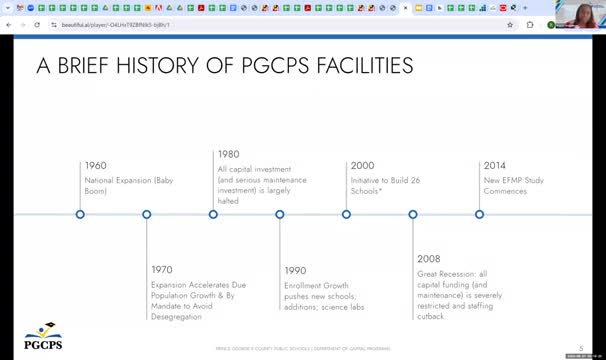Schools face crisis as funding and facilities crumble
September 13, 2024 | Prince George's County Public Schools, School Boards, Maryland
This article was created by AI summarizing key points discussed. AI makes mistakes, so for full details and context, please refer to the video of the full meeting. Please report any errors so we can fix them. Report an error »

In a recent government meeting, officials discussed the historical and ongoing challenges facing Prince George's County Public Schools (PGCPS) regarding facility conditions and educational adequacy. The meeting highlighted a troubling legacy of inequity in school construction, particularly in the southern regions, where facilities were often built to avoid desegregation rather than to meet quality standards.
The discussion traced the evolution of school infrastructure from the 1960s to the present, noting significant periods of expansion and decline in investment. A key point was the impact of the Great Recession in 2008, which severely restricted capital funding and maintenance, leading to a backlog of repairs and a decline in facility conditions. By 2014, the need for a comprehensive master plan became evident, as many schools were found to be in a state of disrepair, with inadequate facilities failing to support effective education.
The officials outlined a master plan initiated in 2015, focusing on three pillars: facility condition, educational adequacy, and capacity considerations. They emphasized the importance of a data-driven approach to prioritize projects based on the condition of facilities and their ability to provide a safe and effective learning environment. The plan identified a staggering $8.5 billion needed for modernization over 20 years, with an annual funding requirement of $425 million, far exceeding the current average funding of $180 million.
The meeting also addressed the issue of underenrollment in southern schools, which averaged 74% utilization, leading to reduced funding and program offerings. Conversely, northern schools faced overenrollment, with some projected to exceed 200% capacity, exacerbating safety and educational quality concerns. The officials noted that addressing these disparities is crucial for equitable resource allocation and effective educational delivery.
Looking ahead, the officials plan to update the master plan to incorporate new educational initiatives and sustainability goals, with a focus on community engagement to ensure that the needs of all stakeholders are met. The meeting concluded with a commitment to continue addressing the historical inequities in school facilities and to prioritize investments that will enhance educational outcomes for all students in the district.
The discussion traced the evolution of school infrastructure from the 1960s to the present, noting significant periods of expansion and decline in investment. A key point was the impact of the Great Recession in 2008, which severely restricted capital funding and maintenance, leading to a backlog of repairs and a decline in facility conditions. By 2014, the need for a comprehensive master plan became evident, as many schools were found to be in a state of disrepair, with inadequate facilities failing to support effective education.
The officials outlined a master plan initiated in 2015, focusing on three pillars: facility condition, educational adequacy, and capacity considerations. They emphasized the importance of a data-driven approach to prioritize projects based on the condition of facilities and their ability to provide a safe and effective learning environment. The plan identified a staggering $8.5 billion needed for modernization over 20 years, with an annual funding requirement of $425 million, far exceeding the current average funding of $180 million.
The meeting also addressed the issue of underenrollment in southern schools, which averaged 74% utilization, leading to reduced funding and program offerings. Conversely, northern schools faced overenrollment, with some projected to exceed 200% capacity, exacerbating safety and educational quality concerns. The officials noted that addressing these disparities is crucial for equitable resource allocation and effective educational delivery.
Looking ahead, the officials plan to update the master plan to incorporate new educational initiatives and sustainability goals, with a focus on community engagement to ensure that the needs of all stakeholders are met. The meeting concluded with a commitment to continue addressing the historical inequities in school facilities and to prioritize investments that will enhance educational outcomes for all students in the district.
View full meeting
This article is based on a recent meeting—watch the full video and explore the complete transcript for deeper insights into the discussion.
View full meeting
